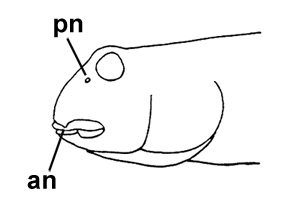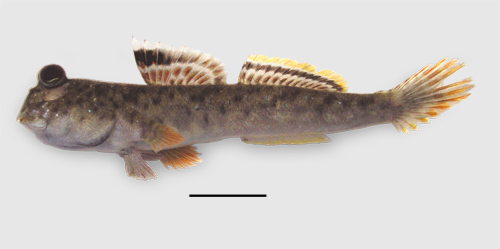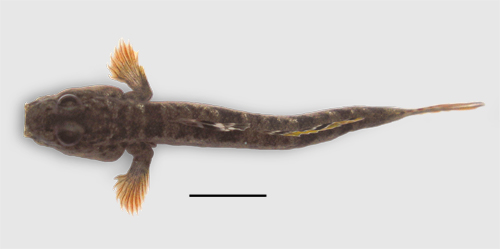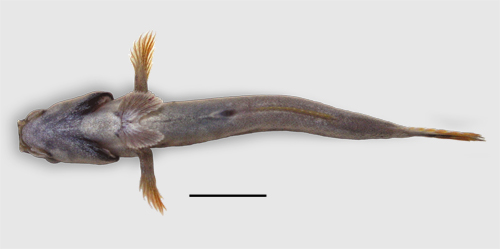Common names:
Philippines |
Tagalog |
bia |
Italy |
Italian |
perioftalmo variabile* |
Malaysia |
Bahasa Malaysia |
ikan belacak insang kelabu |
Thailand |
Thai |
กะจังตีน, kachangtin |
United Kingdom |
English |
dusky gilled mudskipper |
* proposed name
|
|
|
Synonyms:
Periophthalmus variabilis |
Eggert, 1935 |
(senior syn., original combination) |
Periophthalmus variabilis asiaticus |
Eggert, 1935 |
(junior synonym) |
Periophthalmus variabilis sumatranus |
Eggert, 1935 |
(junior synonym) |
Periophthalmus variabilis tidemani |
Eggert, 1935 |
(junior synonym) |
Periophthalmus variabilis variabilis |
Eggert, 1935 |
(junior synonym)
|
Periophthalmus novemradiatus |
(Hamilton, 1822) |
(misapplied name) |
Etymology:
'Periophthalmus' is a compound name from the Greek 'peri' (around), and 'ophthalmôn' (eye), which refers to the wide visual field of these species
'variabilis' means 'variable' in Latin, which refers to the variable morphology of this species, according to the author (Eggert, 1935)
|
Maximum recorded length:
65 mm SL (Polgar & Crosa, 2009)
Live colouration (Jaafar et al., 2009; pers. obs.: Peninsular Malaysia):
ground colour dorsally and laterally brown, ventrally whitish to grey; branchiostegal membrane pigmented; head and trunk with numerous dark brown blotches,
larger on trunk; tiny iridiscent bluish speckles on cheeks and
flanks; 5-8 diagonal, irregular saddle-like dark brown bars may be visible on dorsum; D1 with translucent margin and background, a greyish inframarginal stripe (often anteriorly darker), and proximal rounded to ellyptical red-orange spots between elements; D2
with a yellow margin, a dark brown inframarginal stripe, and a proximal series of brown to reddish spots between elements; caudal fin membrane dusky, rays distally orange with series of brownish speckles; pectoral fins distally orange to reddish;
anal fin whitish to yellowish; pelvic fins whitish to dusky
Colouration on preservation (Jaafar et al., 2009; pers. obs.: Peninsular Malaysia, Indonesia):
ground colour pale to dark brown dorsally and laterally, whitish to greyish ventrally; the irregular saddle
bars and the scattered darker blotches on head and trunk are usually present; ventral margin of gill
covers usually blackened; D1 background transparent with a dark inframarginal stripe and
dark to dusky proximal spots between elements; D2 background transparent with a dark
inframarginal stripe, and dusky spots basally between elements; caudal fin rays dusky with
darker speckles on rays; anal fin whitish to hyaline; pectoral fins dusky; pelvic fins whitish to dusky
Diagnosis (Jaafar et al., 2009):
D1 VIII-XI; total elements of D2 12-13;
total elements of anal fin 11-13; longitudinal scale count 48-60; predorsal scales 17-22;
length of anal fin base 18.3-21.1%SL; D1 with a dark inframarginal stripe (often darker in the anterior portion), reddish orange rounded to elliptical spots in life (dark on preservation), and first spine moderately elongated in larger specimens; D2 with yellow-orange margin, a black inframarginal stripe, and round red-orange spots on the interradial membrane (dark on preservation); pelvic fins with prominent frenum and inner rays united by a basal membrane for less than half
their length. Branchiostegal membrane pigmented.
The genus is yet undefined by synapomorphies
Diet:
carnivorous, opportunistic [crustaceans, insects, etc.:
Swennen et al., 1995 (= P. novemradiatus); pers. obs.]
Reproduction:
no published study is available. It digs turreted burrows in the high mangrove forest (pers. obs.); the details of its reproductive
cycle have not been described in literature: it probably follows the general model proposed for all
the congeneric species (see also Reproductive behaviour)
|
|
Ecological notes [Polgar & Crosa, 2009;
Takita et al., 1999 (= P. novemradiatus) Peninsular Malaysia]:
locally abundant in mangrove ecosystems from the low forest to the high forest zone;
larger individuals are apparently distributed at higher levels in the intertidal zone, a pattern which is inverse relative to other amphibious oxudercine gobies, such as P. gracilis, Boleophthalmus boddarti and Oxuderces dentatus (Polgar & Bartolino, 2010). The disruptive
colouration of P. variabilis allows for efficient camouflage on the forest floor
middle: Carey Island, Malaysia: high mangrove forest; the typical habitat of
P. variabilis (photo: G. Polgar, 2006)
|
|
|
|
Distribution:
South East Asia, from the Malacca Straits to the Sulu Sea (Thailand, Malaysia, Vietnam, Indonesia); type locality (neotype): Cilacap, Java, Indonesia
(Jaafar et al., 2009)
|
|
|
|
Remarks:
Murdy (1989) considered P. variabilis Eggert, 1935 as a junior synonym of P. novemradiatus (Hamilton, 1822). Jaafar & Larson (2008) and Jaafar et al. (2009) restored both species, providing new diagnoses. P. novemradiatus is probably distributed in the Gulf of Bengal, from East India to southern Thailand, where it may occur sympatrically with P. variabilis.
|
Photographs of Periophthalmus variabilis:
|
A: P. variabilis, high forest
(photo: G. Polgar; Sementa, Peninsular Malaysia, 2006); B: a specimen captured
by hand net (photo: G. Polgar; Sementa, Peninsular Malaysia, 2006); C:
a turreted burrow of P. variabilis (photo: G. Polgar; Sementa, Peninsular Malaysia,
2006); D: P. variabilis taking shelter from water on the prop
roots of Rhizophora sp. at high tide (photo: G. Polgar; Kukup Is., Peninsular Malaysia, 2006); E: P. variabilis coming out of its burrow (photo: M.Z. Khaironizam; Kuala Selangor, Peninsular Malaysia, 2001)*; F: close-up (photo: Y. Ikebe, Southern Thailand: Ranong;
mudskipperworld)*;
G: P. variabilis perching on a root at high tide
(photo: G. Polgar; Kukup Is., Peninsular Malaysia, 2007)*;
H: the efficacy of the cryptic colouration on
the forest floor (photo: G. Polgar; Kuala Selangor, Peninsular Malaysia, 1996); I:
another close-up at low tide (photo: G. Polgar; Kuala Selangor, Peninsular Malaysia, 1996); J:
P. variabilis in aquarium (photo: G. Polgar; Kukup Is., Peninsular Malaysia, 2007); K: an individual resting on a log at high tide (photo: G. Polgar; Kukup Is., Peninsular Malaysia, 2007)* with permission
|
Drawings of Periophthalmus variabilis:

cephalic sensory and nasal pores of Periophthalmus spp.: an= anterior nostril; pn= posterior
nostril (modified from Murdy, 1989)* - * with permission
|








